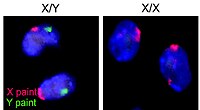
Photo from wikipedia
The sex of birds is determined by inheritance of sex chromosomes at fertilization. The embryo with two Z chromosomes (ZZ) develops into a male; by contrast, the embryo with Z… Click to show full abstract
The sex of birds is determined by inheritance of sex chromosomes at fertilization. The embryo with two Z chromosomes (ZZ) develops into a male; by contrast, the embryo with Z and W chromosomes (ZW) becomes female. Two theories are hypothesized for the mechanisms of avian sex determination that explain how genes carried on sex chromosomes control gonadal differentiation and development during embryogenesis. One proposes that the dosage of genes on the Z chromosome determines the sexual differentiation of undifferentiated gonads, and the other proposes that W-linked genes dominantly determine ovary differentiation or inhibit testis differentiation. Z-linked DMRT1, which is a strong candidate avian sex-determining gene, supports the former hypothesis. Although no candidate W-linked gene has been identified, extensive evidence for spontaneous sex reversal in birds and aneuploid chimeric chickens with an abnormal sex chromosome constitution strongly supports the latter hypothesis. After the sex of gonad is determined by a gene(s) located on the sex chromosomes, gonadal differentiation is subsequently progressed by several genes. Developed gonads secrete sex hormones to masculinize or feminize the whole body of the embryo. In this section, the sex-determining mechanism as well as the genes and sex hormones mainly involved in gonadal differentiation and development of chicken are introduced.
Journal Title: Advances in experimental medicine and biology
Year Published: 2017
Link to full text (if available)
Share on Social Media: Sign Up to like & get
recommendations!